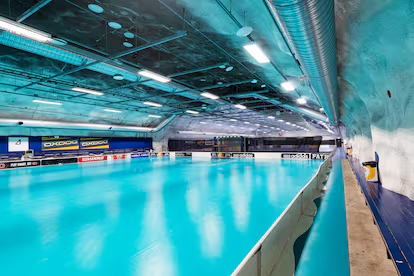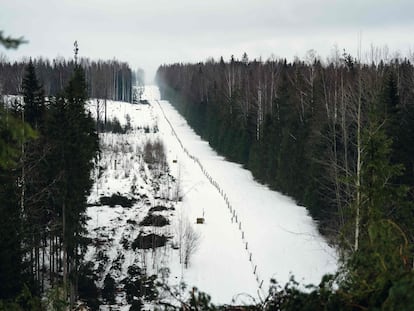Finland on constant alert against Russia
The Nordic country has a network of underground shelters unmatched in the West and the largest number of reservists in the European Union


Children, all blond and wearing red and yellow overalls, are playing indoor football in the center of Helsinki in the middle of winter, but it is not cold. The ball is rolling almost 30 meters underground, in one of the 50,500 underground shelters in Finland. This one, in the Merihaka district, has a café, a playground, a volleyball court, a gym, a floorball court — a sport similar to hockey — and a car park for hundreds of vehicles. It also has everything necessary to house thousands of people in a war or emergency situation.
The Merihaka shelter, built by the municipality in 2003, is accessed from the street by a lift, which is reached through a glass cubicle on the corner of a square. This is the access to the car park and sports facilities, for peacetime. In the event of a conflict or crisis, metal stairs installed in a residential complex would be used. The protected area is entered through two gigantic blue iron doors, separated by an intermediate space equipped with water faucets and intended for disinfection. The first door is designed to withstand an explosion; the second, to block any type of gas or radiation.
Dug into granite rock and covering an area of 14,750 square meters, the Merihaka bunker can be transformed into a shelter for 6,000 people in less than 72 hours. Zigzag corridors with rough, white walls lead to the main pavilions, which, in the event of a crisis, would no longer be used as sports facilities but to house the 2,000 cloth bunks that remain carefully folded and stacked. In adjoining galleries, yellow lines on the floor indicate where the 400 portable latrines should be installed.
Construction on Finland’s network of shelters began in the 1960s and has been continuously expanded and operational ever since. Since the start of the war in Ukraine in February 2022, the authorities have redoubled their efforts to keep them ready in the face of growing Russian assertiveness.
Anna Lehtiranta, a communications officer at the Finnish capital’s rescue department, explains during a recent trip organized by the Finnish Ministry of Foreign Affairs that if the sirens sounded, people would have to go to their assigned shelter carrying food — there are no kitchens in the bunkers — clothes, and blankets. Pets would not be allowed. At Merihaka, the 6,000 guests would be divided into three groups and would take eight-hour rotations: sleeping, working — maintenance, cleaning, etc. — and free time. “We have lists of the jobs people would do if the population had to remain in shelter for two weeks or more,” explains Lehtiranta. “There would be a management department, doctors and nurses, people in charge of looking after children while their parents are at work, and much more.”

In Helsinki, there are 5,500 shelters with a capacity for almost a million people. This is more than enough space to accommodate not only the 650,000 inhabitants of the capital but also residents of other municipalities in the metropolitan area who work in the city, and even hotel guests. Some of the bunkers have go-kart tracks, skate parks, or a swimming pool; others host concerts. Across the country, 87% of the population would have space to be sheltered at the same time (4.8 million places for 5.5 million inhabitants).
Finland is the EU and NATO member state that shares the longest border with Russia, at a little over 830 miles. Mikael Antell, Deputy Director General of the Political Department of the Ministry of Foreign Affairs, stresses that the Nordic country never let down its guard during the decades of the Cold War, in which it remained neutral. “We have never been afraid of Russia, but we have been permanently worried and on alert,” says Antell. “Since the Winter War between Finland and the USSR, at the beginning of World War II, the Finns have not stopped looking after our security and defense,” he stresses. “Even after the fall of the Berlin Wall, when investment in defense plummeted across Europe. It is part of our DNA.”
Comprehensive defense system
Finland’s vast network of shelters is one pillar of a comprehensive defense system that concerns society as a whole and encompasses several government agencies and private sector partnerships. The obligation to contribute to national defense is part of the Finnish Constitution and all men must perform military service. The Nordic country has more than 1,000 agreements with private companies to produce equipment or provide services in times of war and reserves of at least six months of the main fuels and grains are maintained. Last May, Finland began storing weapons, ammunition, and military equipment outside its borders. For the moment, only in neighboring Norway, although it plans to do so in Sweden in the near future.
Voluntary civil defense training courses are organized throughout the country, in which students learn basic safety techniques, first aid, fire-fighting, self-defense, and orientation. For example, one exclusively for women, which lasts a whole weekend and is called “surviving without electricity,” teaches people how to light a fire, cook outdoors, and keep warm. Antell points out that even “the business, political, and cultural elite” frequently attend these types of courses.
During the nearly three years of war in Ukraine, and especially since Finland joined NATO in April 2023, tensions between Helsinki and Moscow have only escalated. In recent months, cyberattacks, disinformation campaigns, sabotage of submarine infrastructure in the Baltic Sea and GPS signal interference have become commonplace. “Finland is not living in times of war, but it is not living in times of peace either,” says a senior official in the Ministry of Defense.
The Finnish military has just 13,000 professional personnel, but a staggering 900,000 reservists and a wartime army with capacity for 280,000 soldiers. Despite being the ninth-smallest EU member state in terms of population, it has the most reservists. Every year, around 20,000 men and around 1,000 women volunteer to serve for six to 12 months.
A recent survey by an official body indicates that around 80% of the population is in favor of maintaining compulsory military service. Other polls place Finland and Sweden as the EU member states where the largest proportion of the population would be prepared to “fight for the country” (around 65%, more than three times as many as in Germany, Italy, or Spain).
“More and more people, especially among the younger generation, believe it is unfair that only men should be required to perform compulsory military service,” says Brigadier General Markku Viitasaari, head of the National Defense Unit at the Ministry of Defense. Even so, Viitasaari stresses, it would be impossible in the medium and short term to accommodate and train almost twice as many recruits each year. In a society where women have such a prominent public presence, the debate is unavoidable.
Sign up for our weekly newsletter to get more English-language news coverage from EL PAÍS USA Edition
Tu suscripción se está usando en otro dispositivo
¿Quieres añadir otro usuario a tu suscripción?
Si continúas leyendo en este dispositivo, no se podrá leer en el otro.
FlechaTu suscripción se está usando en otro dispositivo y solo puedes acceder a EL PAÍS desde un dispositivo a la vez.
Si quieres compartir tu cuenta, cambia tu suscripción a la modalidad Premium, así podrás añadir otro usuario. Cada uno accederá con su propia cuenta de email, lo que os permitirá personalizar vuestra experiencia en EL PAÍS.
¿Tienes una suscripción de empresa? Accede aquí para contratar más cuentas.
En el caso de no saber quién está usando tu cuenta, te recomendamos cambiar tu contraseña aquí.
Si decides continuar compartiendo tu cuenta, este mensaje se mostrará en tu dispositivo y en el de la otra persona que está usando tu cuenta de forma indefinida, afectando a tu experiencia de lectura. Puedes consultar aquí los términos y condiciones de la suscripción digital.
More information
Archived In
Últimas noticias
ICE raids trigger school absenteeism and traumatize children: ‘They have been forced to leave their childhood behind’
The guardians of the meteorites of the Argentine Chaco
Helen Levitt, the photographer who captured the theater of the everyday
Maude Apatow, from acting in ‘Euphoria’ to directing: ‘There are many films that you can tell weren’t written by someone young’
Most viewed
- Christian Louboutin: ‘Young people don’t want to be like their parents. And if their parents wear sneakers, they’re going to look for something else’
- US sanctions against jailed cartel leader ‘El Marro’ highlight Mexico’s lack of control over its prisons
- The low-cost creative revolution: How technology is making art accessible to everyone
- Liset Menéndez de la Prida, neuroscientist: ‘It’s not normal to constantly seek pleasure; it’s important to be bored, to be calm’
- Cartels in Mexico take a leap forward with narco-drones: ‘It is criminal groups that are leading the innovation race’










































